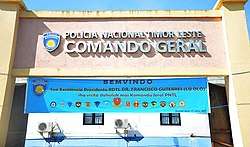East Timorese Portuguese
East Timorese Portuguese (Português timorense in Portuguese) is a Portuguese dialect spoken in the country of Timor-Leste or East Timor. It is one of the official languages of Timor-Leste alongside Tetum.
| East Timorese Portuguese | |
|---|---|
| português timorense, português de Timor Leste | |
Native speakers | 489,113 (2015)[1] |
Indo-European
| |
| Language codes | |
| ISO 639-3 | – |
| Glottolog | None |
| IETF | pt-TL |
History
Timorese Portuguese is a legacy of Portuguese rule of Timor-Leste (called Portuguese Timor) from the 16th century. It had its first contact during the Portuguese discoveries of the East, but it was largely exposed to Portuguese Timor in the 18th century after its division from the rest of the island by the Netherlands.
However, Tetum remained the main lingua franca of Timor-Leste during Portuguese rule, although the most commonly used form, known as Tetun-Prasa used in Dili, was heavily influenced by Portuguese. Following the Carnation Revolution in Portugal in 1974, political parties emerged in Portuguese Timor for the first time, all of which supported the continued use of Portuguese, including APODETI, the only party to advocate integration with Indonesia, which stated that it would support the right to "enjoy the Portuguese language" alongside Indonesian.[2]
On 7 December 1975, nine days after declaring independence from Portugal, Timor-Leste was invaded by Indonesia, which declared the territory as its 27th province in 1976, with Indonesian as the sole official language. During the Indonesian occupation, the use of Portuguese in education, administration and the media was banned by the Indonesian authorities, which saw the language as a threat.[3] This was despite the fact that the 'People's Assembly', which petitioned President Suharto for integration with Indonesia, conducted its proceedings in Portuguese, under a banner reading "Integração de Timor Timur na República da Indonésia" (Integration of East Timor into the Republic of Indonesia).[4]
The last school to teach in Portuguese, the Externato São José, was closed in 1992.[5]
The reintroduction of Portuguese as an official language aroused criticism amongst Indonesian-educated youth, but according to the 2004 census, 36.7% of respondents aged 6 years and older (or 272,638 out of a total of 741,530) said they had “a capability in Portuguese.” [6]
Social context

After independence, Portuguese was restored by the new government of Timor-Leste as one of the official languages with Tetum, with Indonesian and English as "working languages". Timor-Leste asked for help from Brazil, Portugal, and the Latin Union to spread the teaching of the language, although its prominence in official and public spheres has been met with some hostility from younger Indonesian-educated East Timorese.
Some people in Timor-Leste have complained that teachers from Portugal and Brazil are poorly equipped to teach in the country, as they do not know local languages, or understand the local culture.[7] Nevertheless, the late Sérgio Vieira de Mello, who headed the United Nations Transitional Administration in East Timor, was a Brazilian who not only established a close working relationship with Xanana Gusmão (the country's first president) as a fellow Portuguese-speaker, but was respected by many East Timorese because of his efforts to learn Tetum.[8]
Phonology
The Portuguese dialect of the East Timorese people is similar to other Lusophone Asian dialects, like the Indian, Malaysian and Indonesian ones, and to some extent, the African as well. The translation for “please” is por favor. It is [puʁ faˈvo] in Brazilian colloquial speech, [poʁ faˈvoʁ] or [poɾ faˈvoɾ] in Brazilian educated speech, [po faˈvo] in Timor-Leste, but [puɾ fɐˈvoɾ] in European Portuguese. East Timorese and Mozambican accents are intelligible, local government and schools are strict to teach European dialect, as Macau, Portugal and PALOP countries use, because European is the chosen pronunciation, the native pronunciation is closer to European than Mozambican even though it is midway between European and Mozambican dialects, so it is common for foreigners to hear [puɾ fɐˈvoɾ] being used in Timor-Leste.[9] The Portuguese standard phonology is slightly affected by Tetum and other native languages, even though it is not a mother language of the population.
Orthography
Timor-Leste uses the standard European Portuguese (português-padrão) spelling patterns: which is used by Portugal, PALOP and Macau.
See also
References
Bibliography on the language situation and teaching Portuguese in East Timor
- https://www.thejakartapost.com/news/2012/04/20/timor-leste-tetum-portuguese-bahasa-indonesia-or-english.html
- East Timor: Nationalism and Colonialism Jill Jolliffe, University of Queensland Press, 1978, page 326
- Colonization, Decolonization and Integration: Language Policies in East Timor, Indonesia
- The Making of Tim-Tim, Robert Kroon, TIME, June 14, 1976
- New World Hegemony in the Malay World, Geoffrey Gunn, The Red Sea Press, 2000, page 224
- A New Country’s Tough Non-Elective: Portuguese 101, Seth Mydans, The New York Times, July 31, 2007
- La'o Hamutuk Bulletin (August 2003). "Brazilian Aid to East Timor". La'o Hamutuk.
- Office of the United Nations High Commissioner for Human Rights (21 August 2003). "Two New Zealanders pay tribute to Sergio Vieira de Mello". New Zealand Herald. Archived from the original on 2 February 2008.
- https://www.asiabyafrica.com/point-a-to-a/east-timor-fretilin-independence-mozambique